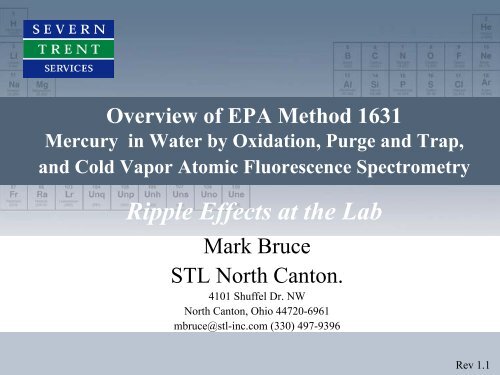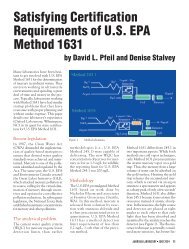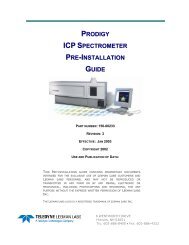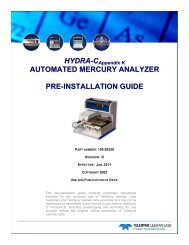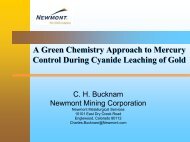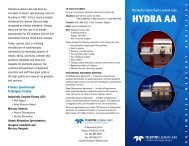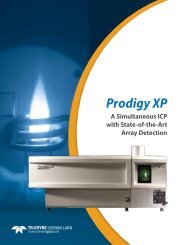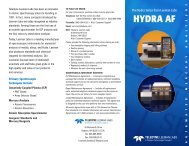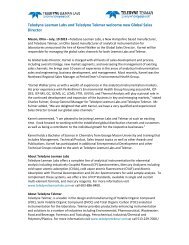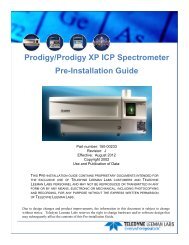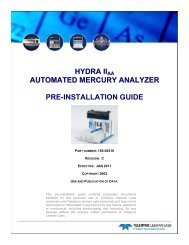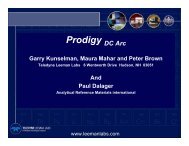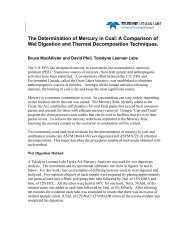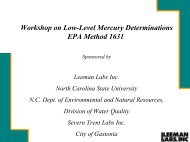Overview of EPA Method 1631 - Teledyne Leeman Labs
Overview of EPA Method 1631 - Teledyne Leeman Labs
Overview of EPA Method 1631 - Teledyne Leeman Labs
Create successful ePaper yourself
Turn your PDF publications into a flip-book with our unique Google optimized e-Paper software.
Laboratory Client Education• Testing Drivers• Client background• Sampling• Shipping
Analytical Driver• Bio-accumulation in food chainwater > microbes > small fish >medium fish > large fish > mammalsH 2 OH 2 OH 2 O HgH 2 OH 2 O
Fish Stories
New Units <strong>of</strong> Measure• Old units– parts per billion - micrograms per liter (µg/L)• New units– parts per trillion - nanograms per liter (ng/L)• One part per trillion– about one pinhead-sized drop <strong>of</strong> mercury inan Olympic-sized swimming pool.
Client Background• Historical mercury results?• Permit / Local regulatory limit?• Required method(s): <strong>1631</strong>? 245.7?
Sampling• <strong>Method</strong>s 1669 & <strong>1631</strong>• Collection technique• Cleanliness• QC (equipment & field)
1669 / <strong>1631</strong> Field & EquipmentQC “Requirements”• Equipment blanks (1669 Sec. 9.3)– bottle blanks– sampling equipment blanks - all equipment• Field blanks (10% frequency) (1669 Sec. 9.4)– pretested water available from STL (2.5L bottles)• Field duplicate (10%frequency)(1669 Sec.9.5)• MS/MSD (1 pair per 10 site samples) (<strong>1631</strong> Sec. 9.3)• Trip blank (not in methods, optional from lab)
Labeling, Shipping• Client sample label on outer bag• Client labels on individual Hg bottles– optional but not recommended• Field preservation– accumulate before shipping– higher risk <strong>of</strong> contamination• Lab preservation– overnight ship, on ice, same day collected– lower risk <strong>of</strong> contamination
Lab Receiving• Unpack cooler• Compare client label on outer bagto COC• Inspect double bag for integrity• Keep double bags intact• Immediately pass along to metalsfor preservation
Sample Preservation &Preparation• Sample bags & bottles openedin mercury clean area• Preserved ≤ 2 days <strong>of</strong> sample collection• BrCl in HCl solution added to each bottle– Stops biological activity– Oxidizes organic/inorganic mercurycompounds– Solubilizes Hg 2+• Screening - instrument protection&dilution
245.7 Summary• Reporting Limit : 5 ng/L• BrCl Oxidizer / Preservative• NH 2 OH HCl prereduction for free Br & Cl• SnCl 2 reduction <strong>of</strong> Hg 2+ to Hg 0• Purge Hg 0 from water with Ar or N 2• Cold vapor atomic fluorescencespectrometer
<strong>1631</strong> Summary• Reporting Limit : 0.5 ng/L• BrCl Oxidizer / Preservative• NH 2 OH HCl prereduction for free Br & Cl• SnCl 2 reduction <strong>of</strong> Hg 2+ to Hg 0• Purge Hg 0 from water with Ar or N 2• Trap Hg 0 on Au coated sand• Thermally desorb Hg 0 into Ar stream• Cold vapor atomic fluorescence spectrometer
<strong>Method</strong> Diagrams<strong>Method</strong> 245.7 : <strong>Leeman</strong> <strong>Labs</strong>, Hydra AFHg +2Hg 0SnCl 2ArgonHg LampLiquid / GasSeparatorDetectorCellSignal<strong>Method</strong> <strong>1631</strong> : <strong>Leeman</strong> <strong>Labs</strong>, Hydra AF GoldHg +2Hg 0SnCl 2ArgonLiquid / GasSeparatorHg LampAu TrapDetectorCellSignal
<strong>1631</strong> Calibration (40 mL)Concng/L Peak areaBlksubtractedareaCal FactorCalcconcng/L %R QC check pg on trap QC check0 11809 avg blk 0.090 Pass 3.6 Pass0 10865 0.093 ng/L 0.083 Pass 3.3 Pass0 14091 12255 0.108 Pass 4.3 Pass0.5 82438 70183 140366 0.54 107% Pass1 142548 130293 130293 1.00 100%2 276772 264517 132259 2.02 101%5 656748 644493 128899 4.92 98%10 1280727 1268472 126847 9.69 97%25 3183884 3171629 126865 24.23 97%avg CF 130921%RSD 4% Pass
<strong>Method</strong> Detection Limits<strong>Method</strong> Spike Conc MDL245.7 5.0 ng/L 0.91 ng/L<strong>1631</strong>C 0.25 ng/L 0.12 ng/L
Lab Contamination ControlReagentsWaterHClKBrKBr0 3SnCl 2Analystgloveslab coatdental workEnvironmentair - vapor/particulatesthermometer, manometer, barometerbench topventilation hoodNH 2 OH• HClEquipmentAr sample bottle autosampler vialhoses & tubesgas supply linegas/liquid separatorpipet tips
Low Level Mercury Area• Limited access• Non-metallic (or coated) fixtures• Designated Separate Spacesfor different parts <strong>of</strong> the process
Implementation Summary• Study background <strong>of</strong> analytical technique• Contamination investigation• Instrument– hardware– instrument control– data processing• Lab facility design• Lab process design• Comment on <strong>EPA</strong> <strong>1631</strong>D revision
Proposed <strong>Method</strong> <strong>1631</strong>D• Automated system guidance• Mandated clean handling techniques,equipment and facilities• Blank acceptance criteria < MDL– quantitative criteria– non-quantitative MDL region• Extended unpreserved holding time
UnpreservedHolding Time Study• Current hold time - 48 hours• N Bloom opinion - 100 years• STL study - at least 35 days
Report for<strong>EPA</strong> Office <strong>of</strong> Water•Study partiallyfunded by<strong>EPA</strong> OW•Report includedin <strong>1631</strong>D docketHOLDING TIME STUDYFORUS <strong>EPA</strong> METHOD <strong>1631</strong>Prepared byMark L. Bruce Ph.D.Technical Director(330) 966 7267mbruce@stl-inc.comJULY 27, 2001STL North Canton4101 Shuffel Drive NWNorth Canton, OH 44720-6961Tel 330 497 9396Fax 330 497 0772www.stl-inc.comSummaryUS <strong>EPA</strong> <strong>Method</strong> <strong>1631</strong>C is required or recommended for total mercury analysis in many types <strong>of</strong> watermatrices in the low parts per trillion concentration range. Currently the method requires that the watersample be preserved with either HCl or BrCl within 48 hours <strong>of</strong> sample collection. Preservation in the fieldinvolves the shipment <strong>of</strong> hazardous chemicals and additional manipulations that increase the risk <strong>of</strong>accidental contamination. Thus, preservation at the laboratory is preferred. To accomplish lab preservationcurrently necessitates overnight shipment on the day <strong>of</strong> collection and day <strong>of</strong> receipt preservation at thereceiving laboratory. This rapid action in the field and in the lab is possible most <strong>of</strong> the time but there arenumerous instances where this rapid sample handling is impractical, expensive and in some casesimpossible. Lengthening the unpreserved holding time would facilitate more efficient sample handling bothin the field and at the laboratory.This holding time study was undertaken to demonstrate that total mercury content in water sample is stablefor much longer than 48 hours. Four different types <strong>of</strong> water samples (reagent water, freshwater pond,industrial effluent and POTW effluent) with concentrations between 1 and 5 ng/L were studied over a 35day period. Aliquots <strong>of</strong> each sample were held unpreserved for 7, 14, 21, 28 and 35 days. The sampleswere then analyzed by <strong>Method</strong> <strong>1631</strong>. Statistical comparisons <strong>of</strong> the linear least squares regression line <strong>of</strong>each sample data set indicates there was no significant change in concentration during the 35 day period <strong>of</strong>the study. Thus, the unpreserved sample holding time for total mercury as measured by <strong>Method</strong> <strong>1631</strong>should be extended to at least 28 days provided the sample is oxidized in the original sample collectioncontainer.The data from the freshwater pond sample indicates the presence <strong>of</strong> matrix interferences that affect not onlyits results but also from samples analyzed shortly thereafter. If high organic content samples are to becommonly determined by <strong>1631</strong> additional guidance should be provided in the method to help diagnose andremedy such situations to maintain the high level <strong>of</strong> data quality that <strong>1631</strong> was designed to produce.
HgstabilityunpreservedStability - POTW Effluent4Hg ng/L3210slope (ng/L/day) < t x sqr(var)0.0122 < 0.53slope not different from zero∴ total Hg stable for 35 days0 10 20 30 40Days from Collection
HgstabilityunpreservedStability - Industrial Effluent2.0Hg ng/L1.51.00.50.0slope (ng/L/day) < t x sqr(var)0.0058 < 0.23slope not different from zero∴ total Hg stable for 35 days0 10 20 30 40Days from Collection
Hgstabi lityunpreservedAccuracy & Precisionover 35 days• Deionized water– average 4.92 ng/L– 98% recovery– 6% RSD• Surface water– average 4.89 ng/L– 19% RSD• Industrial effluent– average 1.29 ng/L– 10% RSD• POTW Effluent– average 3.05 ng/L– 10% RSD
<strong>Method</strong> <strong>1631</strong>CUnpreserved Holding TimeSummary• Plot concentration vs. time– No trend slopes different from zero∴ no change in concentration over time• Practical Reporting Time = 35 days• Unpreserved holding time > 28 days• Complete study was presented– PittCon March, 2002– 25th Annual Conference on Analysis <strong>of</strong> Pollutants inthe Environment May, 2002– www.stl-inc.com
Closing Summary• Testing Drivers:– Regs based on bio-accumulation• Client background:– analytical & reg. needs• Sampling:– clean hands/dirty hands• Shipping & Receiving:– short hold time to preservation, don’t contaminate• Sample preservation / preparation:– clean designated spaces, contamination control training• Analysis (<strong>1631</strong>C):– RL 0.5 ng/L, MDL 0.12 ng/L
Acknowledgments<strong>Leeman</strong> <strong>Labs</strong>, Inc.US FilterUnited StatesEnvironmental Protection Agency


